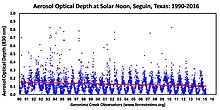
Back عمق ضوئي Arabic আলোক গভীরতা Bengali/Bangla Profunditat òptica Catalan Optische Dicke German Profundidad óptica Spanish عمق نوری Persian Optinen paksuus Finnish Épaisseur optique French Optička debljina Croatian Optikai mélység Hungarian

In physics, optical depth or optical thickness is the natural logarithm of the ratio of incident to transmitted radiant power through a material. Thus, the larger the optical depth, the smaller the amount of transmitted radiant power through the material. Spectral optical depth or spectral optical thickness is the natural logarithm of the ratio of incident to transmitted spectral radiant power through a material.[1] Optical depth is dimensionless, and in particular is not a length, though it is a monotonically increasing function of optical path length, and approaches zero as the path length approaches zero. The use of the term "optical density" for optical depth is discouraged.[1]
In chemistry, a closely related quantity called "absorbance" or "decadic absorbance" is used instead of optical depth: the common logarithm of the ratio of incident to transmitted radiant power through a material. It is the optical depth divided by loge(10), because of the different logarithm bases used.
- ^ a b IUPAC, Compendium of Chemical Terminology, 2nd ed. (the "Gold Book") (1997). Online corrected version: (2006–) "Absorbance". doi:10.1351/goldbook.A00028